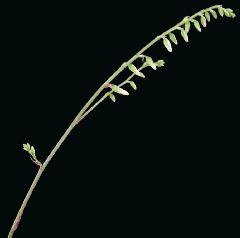


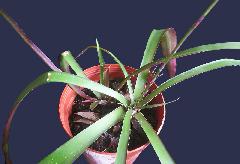
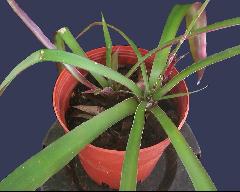
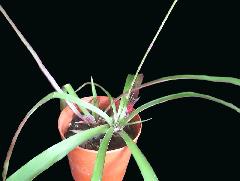
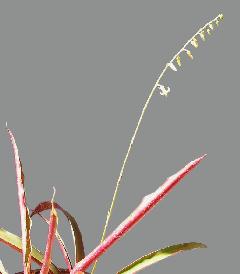

Fosterella latifolia sp. nov. IBISCH, VASQUEZ & GROSS. Boliviana de Botanica 2(2): 117-132. 1999
Type: BOLIVIA: Departamento SANTA CRUZ: Province Florida, Refugio Volcanes, in understory of semihumid forest, 18°05' S, 63°40' W, ± 1,000 m, 16.5.1998, P. Ibisch 98.98 (Holotype: LPB; isotypes: USZ, FR).
Ab omnibus speciebus Fosterellae cum petalis leviter recurvatis vel rectis et foliis pagina inferiore lepidotis ab foliis late lanceolatis, carnosis, pagina inferiore vulgo rubellis et multum latioribus differt.
Plant stemless, flowering up to 1,20 m high.
Leaves forming a rosette, up to 1 m in diameter.
Sheaths narrow-ovate, 2-3 cm high, 1,5-2 cm wide, very succulent, glabrous.
Blades sub-erect to attached to the ground, acuminate-obtuse, broadly lanceolate, up to 50 cm long, to 5-8 (-10) cm wide, to 5 mm thick, somewhat constricted at base, not definitely petiolate, entire, dark green, often reddish beneath, glabrous above, sparsely lepidote beneath, nerved.
Scape erect, to 70-80 cm long, red, white-lepidote, 5-7 mm thick, often somewhat waxy.
Scape bracts erect, triangular, acuminate, lepidote, red, always longer than the internodes, entire.
Inflorescence laxly tri-pinnate, erect, 20-30 cm long, 10-20 cm wide, axes red, lepidote.
Primary bracts lanceolate-acuminate, the lower to 3 mm wide and 15 mm long, lepidote beneath.
Branches erect-spreading, up to 13 cm long.
Floral bracts 2-3 mm long, usually longer than the pedicels.
Flowers laxly arranged, secund/nutant. Pedicels 1-2 mm long.
Sepals 2-3 mm long, glabrous, reddish.
Petals 4-5 mm long, white, recurved but not recoiled, becoming straight at postanthesis,
stamens and style exposed at anthesis.
Although this species, especially at humid and humus-rich sites, can have a rather robust appearance (plants having very long inflorescences with thick scapes and very wide leaves), fertile plants of less favourable sites can be quite small (flowering not more than 30-40 cm high, leaves about 3 cm wide).
Even flower size can vary a lot. This new taxon differs from all other known species of Fosterella with straight, not recurved petals and abaxially lepidote leaves by its broadly lanceolate, fleshy and much wider leaves, which are mostly reddish beneath.
Etymology: The epithet refers to the fact that this new species presents by far the widest leaves of the genus.
Fosterella latifolia Ibisch, Vasquez & Gross, Vasquez & Gross, Rev. Soc. Bol. Bot. 2(2): 123. 1999.
TYPE: Bolivia. P. Ibisch 98.0098 (Holotype: LPB!; Isotypes: FR!, USZ!).
Detail from Selbyana 23(2): 204-219. 2002
Comparing living plants of several species, we have observed that Fosterella latifolia, as a sterile plant, is quite similar to F. villosula. The latter can develop wide leaves (>5 cm), nearly as wide as F. latifolia. Both have entire leaves somewhat constricted at the base and can be reddish beneath (in F. villosula purely green leaves may be more common). They are distinct, however; the differentiation is important, especially in Santa Cruz, where both occur. The petals of F. latifolia are larger, 8 mm X 2-3 mm, oblong- obovate, and not 7 mm X 1-2 mm, lanceolate, as in F. villosula. The sepals of F. latifolia are dark-green to somewhat reddish and glabrous, and not clear-green and lepidote. The floral bract is papyraceous and glabrous and not green and lepidote. The leaves are not so visibly channeled as in F. villosula, and the axis of the inflorescence is glaucous-glabrous (epicuticular waxes) and not lepidote. Fosterella villosula seems to prefer humid forests, and F. latifolia semihumid forests.
Although Fosterella latifolia morphologically differs from F. penduliflora, preliminary molecular data suggest they are close relatives (Rex 2001, Rex et al. 2001; FIGURE 1). A closer look at the F. penduliflora group, which may either represent only one very variable species or several closely related species, is needed.
See also Detective Derek article DD0507: